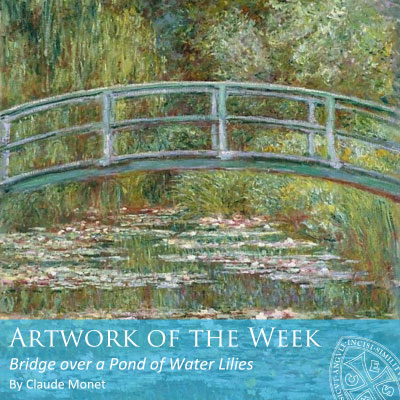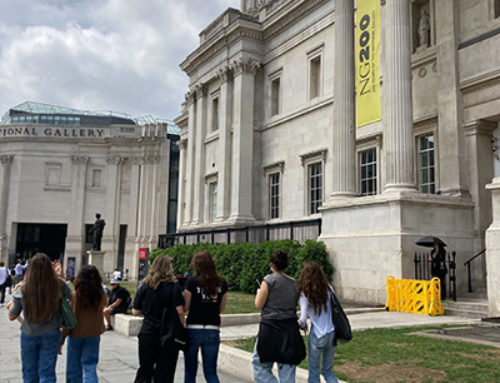Monet’s idyllic painting depicts lilac water lilies in a pond under the bridge near his residence in Giverny, France. Monet was in search for a tranquil image evoking “pleasure of the eye” and he ended up painting a series of eighteen views of the wooden footbridge over the pond completing them all in one summer, which I find truly extraordinary. The hues of the cool color palette Monet employed convey the intensity and saturation of the lush greenery that surrounds the pond, bringing the to life the idyllic landscape. The careful use of perspective and overlapping adds a sense of depth and dimension to the painting, creating a strikingly realistic portrayal of the scene. The still water with its deliberate delicate placing of groups of water lilies receding into the centered horizon line contributes to the painting’s sense of balance and harmony, while the bridge’s symmetrical structure and the vertical emphasis of the surrounding greenery enhance its overall sense of order.
Monet’s artistic brilliance is evident in the surreal reflections of the water lilies on the calm surface of the pond. The subtle play of light and shadow creates an ethereal quality, a motif of impressionist art and evidence of Monet’s ability to capture the ephemeral nature of light and its interplay with the natural world. His use of shades and tones of the same color on the water renders the painting in a naturalistic way seeming as though a frontal light source is illuminating the lilies’ reflections. The heavy impasto technique employed by Monet highlights the different textures of the natural world allowing viewers to experience the artwork in a multi sensory way. From the smooth and delicate petals of the water lilies to the roughened surface of the wooden bridge, and the coarse bark of the surrounding trees and bushes the impasto allows the viewer to experience the painting in a multi-sensory way and feel the idiosyncracity of Monet’s style. Presented in a vertical orientation, the painting draws the viewer’s gaze towards the water lilies in the foreground, inviting them to immerse themselves in the tranquil ambiance of Monet’s viewpoint. The artist’s deep connection with the scene becomes palpable, as if one could almost step into his shoes and experience the scene from his perspective.
Over the years, the rich and vibrant oil pigments have retained their brilliance, preserving the artwork’s original look and this is one of the things I find most extraordinary! What attracted me to this painting out of the vast collection of works in the Met was the sense of reality and authenticity conveyed through the vertical almost portrait close up snapshot of Monet’s prestigious home town. The cool yet saturated colour palette used also stood out to me and the naturalistic separation between the foreground middle ground and background blending together harmoniously is impressive.
Click here to view the artwork on The Met website.
Gaia S, Sixth Form Art History Rep














